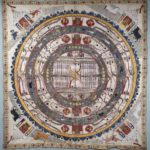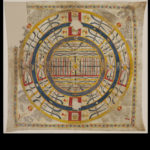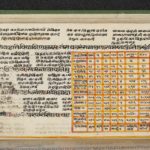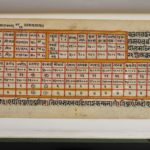Article: Mathematics of the universe
Jain cosmology observes mathematical principles found in calculations and geometry formulae. Mathematics is an intellectual field to which Jain theorists have made valuable contributions. More importantly, it is a way of thinking about and mentally organising details of the universe and time in a coherent manner. Classifying space and time into measurable units and seeing recurring patterns in these units, categories and structure of units is a feature of the Jain approach to cosmology.
The unique Jain notion of the universe has deep religious significance. Understanding the whole concept and the different elements that form it, including the structure, cycles of time and actions over time, is vital to spiritual progress. Crucial religious ideas – such as the physical soul going through the cycle of birth, being reborn in different parts of the three worlds, in order to gain omniscience and then liberation – are tied into understanding traditional cosmology. For this reason, passing on accurate knowledge of Jain cosmology has been an important part of scholarly work for centuries.
Communicating information about the universe is based on texts, including scriptures and popular stories, but images of the universe have also been important teaching aids since the earliest times. Since Jain cosmology is remarkably intricate, with recurring patterns, such descriptions and artwork can seem confusingly exhaustive and repetitive.
Units of time and space
The Jain universe is thought of in terms of dimensions and quantities of units. These ideas are discussed at length in philosophical and sacred literature, starting with definitions of time and space units. Jain thinkers have produced a vast vocabulary to describe and understand units of time and space, going from the smallest to the largest, beyond what can be imagined.
Components of Jain cosmology are classified in one of the following ways:
- numerable – saṃkhyeya
- innumerable – asaṃkhyeya
- infinite – ananta.
The smallest unit of physical matter is the atom. Infinite combinations of atoms make up the smallest unit of measurement that can be counted. This is called the ‘extremely fine’.
Similarly, the Jains have gone into great detail in analysing the extremely large or highly numerous (Plofker in Granoff 2009: 65ff.).
Dimensions and quantities

Distances separating the suns and moons
Image by British Library © CC0 1.0 (Creative Commons Public Domain)
Cosmological texts detail the quantities and proportions of parts of the universe. There are many examples of the vital part mathematics plays in traditional Jain concepts of the universe.
One is the location and number of certain items. For instance, in the middle world of humans, the Jyotiṣka gods – the astral bodies such as planets – are distributed as follows:
- Jambū-dvīpa – 2 suns, 2 moons
- Lavaṇa-samudra – 4 suns, 4 moons
- Dhātakīkhaṇḍa – 12 suns, 12 moons
- Kālodadhi – 42 suns, 42 moons
- Half-Puṣkara – 72 suns, 72 moons.
Each moon has the following retinue of:
- planets – 88
- constellations – 28
- stars – 6,697,500,000,000,000,000,000.
A second example is the dimensions of the various continents and oceans that make up the Two and A Half Continents.
|
Name |
Size in yojanas |
|---|---|
|
100,000 |
|
|
Lavaṇa-samudra |
200,000 x 2 (east and west) = 400,000 |
|
Dhātakīkhaṇḍa |
400,000 x 2 = 800,000 |
|
Kālodadhi |
800,000 x 2 = 1,600,000 |
|
Half-Puṣkara |
800,000 x 2 = 1,600,000 |
|
4,500,000 yojanas in total |
Repetition and symmetry

Temples and trees on Mount Meru
Image by British Library © CC0 1.0 (Creative Commons Public Domain)
The mathematical characteristics of recurrence and symmetry are very noticeable features of Jain cosmology. The universe is ‘a self-replicating composite’ (Granoff 2009: 56). These qualities are especially obvious in the intricate pictures of the universe, which may make them puzzlingly complex.
There are plenty of illustrations of the universe’s repetitive, symmetrical nature, chiefly in the three worlds. Examples abound in the middle world, particularly in the Two and A Half Continents, where humans live.
Firstly, the 45 continents of the middle world are all modelled on the central continent of Jambū-dvīpa.
Next, each of the 90 continents and oceans is bigger by a factor of two than the one inside it.
Thirdly, in the Two and a Half Continents there are a total of five Mount Merus, the cosmic axis, distributed as follows:
- one at the centre of Jambū-dvīpa
- two in the second continent of Dhātakīkhaṇḍa, one per half
- two in the inner part of the third continent of Puṣkara, one in each half.
In addition, Jambū-dvīpa has many features that are noticeably identical, symmetrical or both. For instance, the landmass itself demonstrates recurring, often symmetrical, proportions of mountains, regions, lakes, rivers and so on.
Prominent examples include the regions of Airāvata, Bharata and Mahā-videha. The northern region of Airāvata is a mirror image of Bharata, the southern region. Jambū-dvīpa’s ten capital cities are equally divided between Bharata and Airāvata. They sit between identical branches of the river that flows across each region and are all called Ayodhyā. The central region of Mahā-videha is comprised of 32 provinces laid out in two matching sets of eight rectangles. These are either side of each of the twin rivers that flow east and west across the region. Each pair of sets therefore makes up 16 rectangles in the east and 16 in the west.
The next example is the social organisation of the deities in the three worlds. The gods and goddesses have a hierarchical society very similar to traditional Indian cultures, in which the ideal form of government is monarchy.
Finally, in the Lands of Actions – karma-bhūmi – around half of Mount Meru, time moves in cycles. These cycles of descending and ascending periods of time are endless. Although not of equal length, they are characterised by repetitiveness and predictability.
Reading
- Commentary on Tattvārtha Sūtra of Vācaka Umāsvāti
Pandit Sukhlalji - translated by K. K. Dixit
L. D. series; volume 44
L. D. Institute of Indology; Ahmedabad, Gujarat, India; 1974
- Steps to Liberation: 2500 Years of Jain Art and Religion
Jan van Alphen - Etnografisch Museum Antwerpen; Antwerp, Belgium; 2000
- ‘Une peinture cosmologique jaina déposée au Musée Guimet: texte et traduction’
Nalini Balbir - Bulletin d’Études Indiennes
volume 24–25
Association Française pour les Études Indiennes; Paris, France; 2006 to 2007
- ‘Le monde médian: une peinture cosmologique jaina sur tissu déposée au Musée Guimet’
Nalini Balbir - Arts Asiatiques
volume 64
École Française d’Extrême-Orient; Paris, France; 2009
- Elements of Jaina Geography: The Jambūdvīpasaṃgrahaṇī of Haribhadra Sūri
Haribhadra - translated and edited by Frank van den Bossche
Motilal Banarsidass; New Delhi, India; 2007
- Jain Cosmology
Colette Caillat and Ravi Kumar - translated by R. Norman
Bookwise (India) Pct. Ltd; New Delhi, India; 2004
- Essays on Jaina Art
Anand K. Coomaraswamy - edited by Richard J. Cohen
Indira Gandhi National Centre for the Arts and Manohar; New Delhi, India; 2003
- Victorious Ones: Jain Images of Perfection
Phyllis Granoff - Mapin Publishing Pvt. Ltd and Rubin Museum of Art, New York; Ahmedabad, Gujarat, India and New York, USA; 2009
- ‘Oceans, Islands and Sacred Mountains: Representations of Cosmic Geography in Jaina Art and Architecture’
Julia A. B. Hegewald - Cosmos: the Journal of the Traditional Cosmological Society
volume 16
Traditional Cosmological Society; 2000
- ‘Meru, Samavasaraṇa and Siṃhāsana: The Recurrence of Three-Tiered Structures in Jaina Cosmology, Mythology and Ritual’
Julia A. B. Hegewald - Kalhar (White Water-Lily): Studies in Art, Iconography and Archaeology of India and Bangladesh – Professor Enamul Haque Felicitation Volume
edited by Gerd R. Mevissen, Gourishwar Bhattacharya, Mallar Mitra and Sutapa Sinha
Kaveri Books; New Delhi, India; 2007
- Jaina Temple Architecture in India: The Development of a Distinct Language in Space and Ritual
Julia A. B. Hegewald - Monographien zur Indischen Archäologie, Kunst und Philologie series; volume 19
Stiftung Ernst Waldschmidt, G+H Verlag; Berlin, Germany; 2009
- Cosmology Old & New: Being a modern commentary on the fifth chapter of Tattvārthādhigama Sūtra
G. R. Jain - Jñānapīṭha Mūrtidevī granthamālā: English series; volume 5
Bhāratīya Jñānapīṭh Publication; New Delhi, India; 1991
- ‘Lokākāśa and Lokadhātu: A Comparison of Jain and Buddhist Cosmology’
Padmanabh S. Jaini - The Clever Adulteress and Other Stories: A Treasury of Jain Literature
edited by Phyllis Granoff
Mosaic Press; Oakville, Ontario, Canada; New York, USA; London, UK; 1990
- Die Kosmographie der Inder: nach den Quellen dargestellt
Willibald Kirfel - Georg Olms; Hildesheim, Lower Saxony, Germany; 1967
- The Scientific Foundations of Jainism
K. V. Mardia - edited by Dayanand Bhargava
Lala Sunder Lal Jain Research series; volume 5
Motilal Banarsidass; New Delhi, India; 1996
- Die Erlösungslehre der Jaina: Legenden, Parabeln, Erzählungen
- translated and edited by Adelheid Mette
Insel Verlag; Berlin, Germany; 2010
- The Doctrine of the Jainas: Described after the Old Sources
Walther Schubring - translated by Wolfgang Bühlen
edited by Satya Ranjan Banerjee
Lala Sunder Lal Jain Research series; volume 15
Motilal Banarsidass; New Delhi, India; 2000
- That Which Is: Tattvārtha Sūtra
Umāsvāti / Umāsvāmi - translated by Nathmal Tatia
Sacred Literature series
International Sacred Literature Trust in association with Harper Collins; London, UK; 1994
- Treasures of Jaina Bhandāras
Umakant Premanand Shah - L. D. series; volume 69
L. D. Institute of Indology; Ahmedabad, Gujarat, India; 1978
- Tiloyapannatti: Teaching on the Three Worlds
Yativṛṣabha - translated by Pandit Balchandra Shastri
edited by A. N. Upadhye and Hiralal Jain
Jaina Saṃskṛti Saṃrakshaka Sangha series
Jīvarāja Jaina Granthamālā; Solapur, Maharashtra, India; 2008
Links
- Jain Studies in Science
-
Professor M. R. Gelra summarises the Jain faith and how it relates to science in the preface to his 2007 book Jain Studies and Science. The full text is available to read online on the HereNow4U website.
- Jain universe
-
The Herenow4U website provides a detailed diagram of the Jain universe and a summary of traditional cosmology. It is a page from the 2008 edition of Introduction to Jainism by Rudi Jansma and Sneh Rani Jain.
- Digambar Jain Trilok Shodh Sansthan
-
Opened in 1985, the Digambar Jain Trilok Shodh Sansthan – Digambar Jain Institute of Cosmographic Research – in Hastinapur, Uttar Pradesh, was founded by Āryikā Jñānamati. A centre of research into Jain cosmology, the institute publishes the Vira Jñānodaya Granthamālā series and the Samyagjñāna journal and also houses a boys' boarding school. Several temples attract pilgrims but the main draw is the large 3-D model of Jambūdvīpa, complete with a 30-metre-tall Mount Meru.
- Three-dimensional model of Jambū-dvīpa
-
This slideshow from the Digambar Jain Trilok Shodh Sansthan – Digambar Jain Institute of Cosmographic Research – in Hastinapur, Uttar Pradesh, shows photos of its three-dimensional model of Jambudweep – Jambū-dvīpa in Sanskrit – and other pictures of the institute. Some 70 metres across, the model of the first continent houses a 30-metre-tall Mount Meru up which visitors can climb.
http://www.jambudweep.org/gallery/jambudweep-campus-photo-gallery
- +
- aAbhavya
- aAbhinandana
- aAbhiṣeka
- aĀcāra
- aĀcārāṅga-sūtra
- aĀcārya
- aAchalbhrata
- aAḍhāī-dvīpa
- aAdharma
- aAdho-loka
- aAdhyayana
- aAdvaita Vedānta
- aĀgama
- aAghātīya
- aAghātīya-karman
- aAgnibhuti
- aAgra
- aĀhāra
- aAhiṃsā
- aAhimsa Day
- aAjita
- aAjīva
- aAkampit
- aĀkāśa
- aAkbar the Great
- aAkṣaya-tṛtīyā
- aAlauddin Khalji
- aAlbert Einstein
- aAllah
- aAlms
- aĀlocanā
- aAloka-ākāśa
- aAmāri
- aAmbikā or Kūṣmāṇḍinī
- aAnagāra
- aAnanta
- aAnarthadaṇḍa
- aAnaśana
- aAnekānta-vāda
- aAṅga
- aAniconism
- aAnojjā
- aAntarāla
- aAntarāya-karma
- aAṇu
- aAṇu-vrata
- aAnukampā
- aAnuprekṣā
- aAnusvāra
- aApabhraṃśa
- aAparigraha
- aAra
- aĀrambha
- aĀrambhaja
- aĀratī
- aArdhamāgadhī Prākrit
- aArhaṃ
- aArhat
- aArśana-āvaraṇīya-karma
- aĀrta-dhyāna
- aĀryikā
- aĀryikā Jñānamati
- aĀśātanā
- aĀścarya
- aAscetic
- aAsceticism
- aAshram
- aAspiration
- aĀsrava
- aAṣṭa-maṅgala
- aAṣṭāpada
- aAstikāya
- aAstrolabe
- aAsura
- aAtheism
- aAticāra
- aAtiśayakṣetra
- aAtithisaṃvibhāgavrata
- aĀtma-vāda
- aĀtman
- aAuṃ
- aAurangzeb
- aAuspicious
- aAusterity
- aAvadhāna
- aAvadhi-jñāna
- aĀvaraṇī-yakarman
- aAvasarpiṇī
- aAvatāra
- aAvidyā
- aAxiom
- aĀyāga-paṭa
- aĀyambil
- aĀyu-karma
- aĀyurveda
- bBabur
- bBāhubali
- bBaladeva
- bBālāvabodha
- bBandha
- bBasadi
- bBazaar
- bBhadrankarvijay
- bBhagavant
- bBhaktāmara-stotra
- bBhakti
- bBhale
- bBharata
- bBhāṣā
- bBhāṣya
- bBhaṭṭāraka
- bBhāva
- bBhāva-pūjā
- bBhāvanā
- bBhavana-vāsin
- bBhavya
- bBhavyatva
- bBhaya
- bBhoga-bhūmi
- bBhogopabhoga
- bBodhi
- bBollywood
- bBrahmā
- bBrahma-deva
- bBrahmacārī
- bBrāhmaṇa
- bBraj Bhāṣā
- bBright fortnight
- bBritish Raj
- bBuddha
- bBuddhi-sagar
- bBuddhism
- bBuddhist
- cCaitya
- cCaityavāsin
- cCakravartin
- cCakreśvarī
- cCāmara
- cCandanā
- cCandragupta
- cCandraprabha
- cCanon
- cCāritra
- cCāritramohanīya-karman
- cCarũrī
- cCaste
- cCaturvidha-saṅgha
- cCaturviṃśati-stava
- cCāturyāma
- cCE
- cCelibacy
- cCha
- cChadmastha
- cChastity
- cCheda-sūtra
- cChristian
- cChristianity
- cClergy
- cCloning
- cColophon
- cCommentary
- cConch
- cConfession
- cCongregation
- cConsecration
- cCosmology
- cCremation
- cCrore
- cCult
- cCūrṇi
- dDādā-guru
- dDalit
- dDāna
- dDaṇḍa
- dDark fortnight
- dDarśana
- dDarśanamohanī-yakarman
- dDaśa-lakṣaṇa-parvan
- dDeity
- dDelhi Sultanate
- dDerāsar
- dDeśāvakāśika-vrata
- dDetachment
- dDevanāgarī
- dDevānandā
- dDevarddhi-gani
- dDevotee
- dDhamal
- dDhanuṣ
- dDhāra
- dDharma
- dDharma-dhyāna
- dDharma-sāgara
- dDharmastikaya
- dDhātakīkhaṇḍa
- dDholak
- dDhyāna
- dDiaspora
- dDig-vrata
- dDigambara
- dDīkṣā
- dDisciple
- dDīvālī
- dDivya-dhvani
- dDNA
- dDoctrine
- dDogma
- dDonor
- dDoṣa
- dDravya
- dDravya-pūjā
- dDrone
- dDuṣamā
- dDuṣamā-duṣamā
- dDuṣamā-suṣamā
- dDveṣa
- dDvīpa
- eEast India Company
- eEightfold Path
- eEkānta-vāda
- eEkendriya
- eElder
- eElders
- eEschatology
- eEtc up to
- fFarmān
- fFast
- fFatehpur Sikri
- fFestival
- fFestschrift
- fFiruz Shah
- fFly-Whisks
- fFolio
- fFour Noble Truths
- gGaccha
- gGaṇa
- gGaṇadhara
- gGanadharavada
- gGaṇeśa
- gGaṇin
- gGarba
- gGarbha
- gGarbha-gṛha
- gGaruḍa
- gGati
- gGene
- gGenomics
- gGhātī-yakarman
- gGhātīya
- gGhaznavid
- gGhiyasuddin Tughlaq
- gGhurid
- gGloss
- gGotra-karma
- gGujarāt
- gGujarati
- gGuṇa
- gGuṇa-sthāna
- gGuṇa-vrata
- gGupti
- gGuru
- gGuruṇī
- hHagiography
- hHajj
- hHaṃsa
- hHaribhadra
- hHariṇaigameṣin
- hHasta
- hHeresy
- hHiṃsā
- hHindi
- hHindu
- hHinduism
- hHīravijaya
- hHoroscope
- hHrīṃ
- hHumayun
- hHymn
- iIconoclasm
- iIconography
- iIdol
- iIndian Independence
- iIndology
- iIndra
- iIndrabhūti Gautama
- iIndriya
- iInitiation
- iIntercession
- iInvocation
- iIQ
- iIslam
- iIslamicate
- iIṣṭadevatā
- iĪśvara
- jJagat
- jJahangir
- jJain
- jJaina Devanāgarī
- jJaina Śaurasenī
- jJaina-dharma
- jJainaśāsana
- jJainness
- jJaisalmer
- jJamāli
- jJambū-dvīpa
- jJames Burgess
- jJanma
- jJanma-kalyāṇa
- jJarā
- jJāti
- jJina
- jJina-āgama
- jJina-bhavana
- jJina-bimba
- jJina-mātā
- jJinacandra-sūri
- jJinadatta
- jJinaprabha
- jJīva
- jJñāna
- jJñāna-āvaraṇīya-karma
- jJñāna-āvarṇiya
- jJñānsundar
- jJyotiṣka
- kKāla
- kKālakācārya-kathā
- kKālidāsa
- kKalpa-sūtra
- kKalpa-vṛkṣa
- kKalyāṇaka
- kKalyanvijay
- kKamaṇḍalu
- kKamaṭha
- kKarma
- kKarma-bhūmi
- kKarma-grantha
- kKarma-prakṛti
- kKarma-vāda
- kKarmon
- kKarnataka
- kKaṣāya
- kKathā
- kKāvya
- kKāya
- kKāyotsarga
- kKeśa-loca
- kKetu
- kKevala-jñāna
- kKevalin
- kKhalji
- kKharatara-gaccha
- kKnowledge
- kKriyā
- kKriyā-vāda
- kKṛṣṇa
- kKṣamā-śramaṇa
- kKṣapakaśreṇi
- kKṣatriya
- kKṣullaka
- kKulakara
- kKundakunda
- kKunthu
- lLabdhi
- lLaity
- lLakh
- lLāñchana
- lLands of Action
- lLaukāntika
- lLavaṇa-samudra
- lLeśyā
- lLiṅga
- lLinguistics
- lLoka
- lLoka-ākāśa
- lLoka-puruṣa
- lLoka-vāda
- lLotus
- lLotus lake
- mMadhya-loka
- mMahā-videha
- mMahā-vrata
- mMahābhārata
- mMahāmastakābhiṣeka
- mMāhārāṣṭra
- mMāhārāṣṭrī Prākrit
- mMahattarā Yākinī
- mMahāvīr Jayantī
- mMahāvīra
- mMakāra
- mMakkhali Gośāla
- mMalli
- mMāna-stambha
- mManaḥ-paryāya-jñāna
- mMaṇḍala
- mMaṇḍapa
- mMandit
- mMaṅgala
- mMantra
- mMantras
- mManuṣya-loka
- mMarāṭhī
- mMārgaṇā
- mMartyr
- mMarudevī
- mMaṭha
- mMati-jñāna
- mMauryaputra
- mMecca
- mMendicant lineage
- mMetarya
- mMiracle
- mMithyādṛṣṭi
- mMohandas Gandhi
- mMohanīya-karma
- mMokṣa
- mMonastic order
- mMonasticism
- mMonk
- mMonotheism
- mMosque
- mMount Meru
- mMount Sammeta
- mMṛgāvatī
- mMughal
- mMuhammad
- mMuhammad bin Tughlaq
- mMuhpattī
- mMūla-sūtra
- mMūlaguṇa
- mMumbaī
- mMuni
- mMunisuvrata
- mMurad Bakhsh
- mMūrti-pūjaka
- mMuslim
- mMysticism
- nNābhi
- nNāga-kal
- nNāgapurīya Tapā-gaccha
- nNāgarī
- nNāma-karma
- nNamaskāra-mantra
- nNami
- nNandīśvara-dvīpa
- nNandivardhana
- nNandyāvarta
- nNāraka
- nNāraki
- nNasalisation
- nNātha
- nNavrātrī
- nNaya-vāda
- nNemi
- nNidāna
- nniggaṃthāṇa vā 2
- nniggaṃtho vā 2
- nNigoda
- nNihnava
- nNikṣepa
- nNirgrantha
- nNirjarā
- nNirvāṇa
- nNiryukti
- nNiṣidhi
- nNitya
- nNiyati
- nNo-kaṣāya
- nNudity
- nNun
- oOcean of milk
- oOmniscience
- oOrdination
- ppa°
- pPadmaprabha
- pPadmāsana
- pPadmāvatī
- pPādukā
- pPalanquin
- pPalette
- pPañca-muṣṭi
- pPāṇḍava
- pPaṇḍit
- pPandit Dalsukh D. Malvania
- pPandit Sukhlalji
- pPāṇipātra
- pPāpa
- pParamātman
- pParameṣṭhin
- pPāraṇā
- pParigraha
- pPariṇāma
- pParīṣaha
- pParokṣa
- pPārśva
- pPārśvanātha
- pParyāya
- pParyuṣaṇ
- pPaṭa
- pPatan
- pPātra
- pPenance
- pPersian
- pPhala
- pPhilology
- pPicchikā
- pPilgrimage
- pPīr
- pPolymath
- pPoṣadha
- pPossession
- pPothī
- pPrabhas
- pPradakṣiṇā
- pPradeśa
- pPrākāra
- pPrakīrṇaka-sūtra
- pPrākrit
- pPramāda
- pPramukhā
- pPrati-vāsudeva
- pPratikramaṇa
- pPratimā
- pPratiṣṭhā
- pPratyākhyāna
- pPratyakṣa
- pPravacana
- pPrāyaścitta
- pPrayer
- pPre-modern
- pPreach
- pPredestination
- pProtestant
- pProvenance
- pPudgala
- pPūjā
- pPujārī
- pPukharavara-dvīpa
- pPuṇya
- pPūrva
- pPuṣkara-dvīpa
- pPuṣpadanta
- pPyre
- qQur’an
- rRāga
- rRāhu
- rRainy season
- rRajasthan
- rRajasthani
- rRājimatī
- rRajoharaṇa
- rRajput
- rRāma
- rRāmāyaṇa
- rRangoli
- rRās-garbā
- rRasa
- rRathanemi
- rRatna-traya
- rRātri-bhojana
- rRaudra-dhyāna
- rRecto
- rRelic
- rRenunciation
- rRetroflex
- rRevatī
- %Ṛg-veda
- rRite
- rRosary
- %Ṛṣabha
- %Ṛṣabhanātha
- rRupee
- sSaciyā Mātā
- sSādhu
- sSādhvī
- sSāgāra
- sSaint
- sŚaivaism
- sŚaka-saṃvat
- sSallekhanā
- sŚalya
- sSamacatuṣṭha
- sSamādhimaraṇa
- sSamaṇi
- sSāmarambha
- sSamavasaraṇa
- sSāmāyika
- sSaṃbhava
- sSamiti
- sSaṃjñā
- sSaṃkalpaja
- sSaṃsāra
- sSamudghāta
- sSaṃvara
- sSaṃvega
- sSamyak-cāritra
- sSamyak-darśana
- sSamyak-jñāna
- sSamyaktva
- sSaṃyama
- sSanctuary
- sSandalwood
- sSaṇgha
- sSanskrit
- sSant
- sŚānti
- sSapta-bhaṅgi-naya
- sSārambha
- sSarasvatī
- sSarvajña
- sSāsan-devi
- sŚāsana-devatā
- sŚāstra
- %Ṣaṭ-jīvanikāya
- sSatī
- sSatīmātā
- sSatya
- sSchism
- sScribe
- sScripture
- sSect
- sSecularism
- sŚenāī
- sSermon
- sŚeṣavatī
- sSevā
- sSeven fields of donation
- sShah Jahan
- sShantidas Jhaveri
- sShrine
- sSiddha
- sSiddha-śilā
- sSiddhacakra or Navadevatā
- sSiddhānta
- sSiddhārtha
- sSiddhi
- sSikh
- sSikhism
- sŚikṣā-vrata
- sŚīla
- sSin
- sSindh
- sŚītala
- sŚiva
- sSkandha
- sSomanatha
- sŚraddhā
- sŚramaṇa
- sŚrāvaka
- sŚrāvakācāra
- sŚrāvikā
- sŚreyāṃsa
- sŚrī
- sŚrīvatsa
- sŚruta-jñāna
- sŚruta-pañcamī
- sSthānaka-vāsin
- sSthāpanācārya
- sSthāvara
- sSthavira
- sSthiti
- sStrīmukti
- sStūpa
- sSubcontinent
- sSudarshana
- sŚuddhi
- sSudharma
- sŚūdra
- sSufism
- sSukha
- sŚukla-dhyāna
- sSulasā
- sSultan
- sSumati
- sSundarśrī
- sSupārśva
- sSūri
- sSuṣamā
- sSuṣamā-duṣamā
- sSuṣamā-suṣamā
- sSūtra
- sSuyam me ausam! Tenam bhagavaya evamakkhayam
- sSvādhyāya
- sSvāhā
- sSvastika
- sŚvetāmbara
- sŚvetāmbara Terāpanthin
- sŚvetāmbaras
- sSwan
- sSyād-vāda
- tTabla
- tTantra
- tTapā-gaccha
- tTapas
- tTāraṇ Svāmī Panth
- tTattva
- tTattvārtha-sūtra
- tTemple
- tTemple-city
- tThe Enlightenment
- tTheology
- tThree worlds
- %Ṭīkā
- tTilaka
- tTīrtha
- tTīrthaṃkaranāma-karman
- tTīrthankara
- tTransliteration
- tTrasa
- tTrasa-nāḍī
- tTriśalā
- tTriṣaṣṭi-śalākā-puruṣa-caritra
- tTti bemi
- tTughlaq
- tTunk
- uUdumbara
- uUniversal History
- uUpādhyāya
- uUpāṅga
- uUpaniṣads
- uUpāsaka
- uUpasarga
- uUpāśraya
- uŪrdhva-loka
- uUtsarpiṇī
- uUttarādhyayana-sūtra
- vVāhana
- vVaimānika
- vVairāgya
- vVaiṣṇava
- vVaiśramaṇa
- vVaiśya
- vValabhī
- vVanaspatikāya
- vVandana
- vVaṇik
- vVarṇa
- vVāsudeva
- vVāsupūjya
- vVayubhūti
- vVeda
- vVedanīya-karma
- vVegetarianism
- vVehicle
- vVernacular
- vVerso
- vVidyā
- vVidyā-devī
- vVihāra
- vVijñapti-patra
- vVikrama-saṃvat
- vVikṛti
- vVimala
- vVinaya
- vVipāka
- vVirji Vora
- vVirodhaja
- vVīrya
- vVisarga
- vViṣṇu
- vVītarāga
- vVizier
- vVotive
- vVow
- vVrata
- vVS
- vVyakta
- vVyantara
- vVyasana
- yYakṣa
- yYakṣī
- yYantra
- yYaśoda
- yYaśovijaya
- yYati
- yYātrā
- yYoga
- yYoginī
- yYojana







